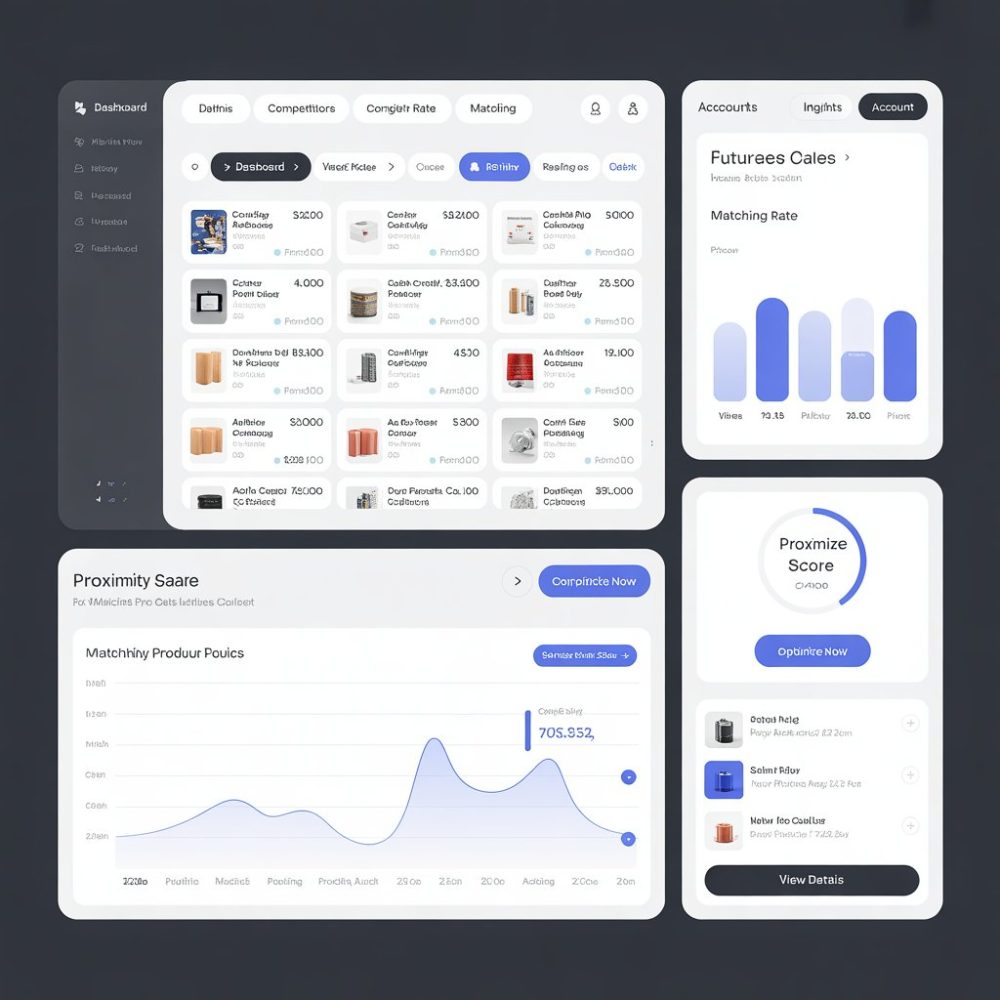PRODUCT MATCHING SOFTWARE
Gain responsiveness and refine your pricing strategy with precise, contextualized product matches.
Automatic matching of any type of code (EAN, Supplier Ref., CIP, etc.)
Matching non-identical products (private label) or products without codes
Proximity score calculation based on textual and non-textual features suggested by AI
Matching by coefficient : Application of coefficients to products sold in different formats.
Integration of all types of data (Web, panelists, customers, etc.)

THEY TRUST US
Product matching:
the essentials for optimizing your pricing strategy
Competitive pressure is intensifying, and consumers are comparing prices with just a few clicks. Simply knowing your own prices is no longer enough: without intelligent market positioning, your prices risk missing their target.
What’s more, without accurate product matching, your price statements lose reliability, undermining your pricing strategy.
To avoid these pitfalls, adopt rigorous product matching thanks to pricing software software. You’ll guarantee the reliability of your data, be able to strategically position your prices against the competition, and build a solid pricing strategy, perfectly adapted to market realities.

How does product matching help optimize sales?
Without accurate product matching, surveys lose their meaning. Correct product alignment guarantees fair comparisons between distributors and avoids biased strategic decisions.
Incorrect matching can have a negative impact on margins and brand image. Good product matching prevents pricing errors visible to consumers who compare “in one click”.
Reliable product matching gives you a clear view of your market position. This enables you to build a coherent, responsive pricing strategy in line with market expectations.
Automated matching speeds up pricing and supply decisions. The brochure claims up to +50% business productivity and 3 times faster private label matching.
Matching helps to link new products to competing equivalents, thus avoiding “grey areas” in assortment/price strategy.
Thanks to adaptable matching rules (tolerances, exclusions, hierarchies, etc.), companies can structure customized pricing alignment strategies.
Product matching : algorithms turn data into sales
With our product matching solution, you benefit from an intelligent module for identifying, matching and comparing your assortments reliably, quickly and strategically.

Reliable product matching to boost competitiveness and optimize pricing strategy
Inaccurate matches generate distorted comparisons, jeopardize your pricing adjustments and undermine your strategic decisions.
OptimiX XPA’s Product Matching module automates the comparison of assortments between distributors, making your matches more reliable and enabling you to adjust your prices accurately, while facilitating the management of your ranges.
Results :
- Precise and exploitable product-competitor alignment
- Greater responsiveness in your supply/pricing decisions
- Clear management of your price image, in line with market expectations
Automatic or manual chain
The module associates your products with those of competitors via intelligent matching based on any type of code (EAN, supplier ref., CIP, etc.). Automation speeds up matching, while the manual mode makes it easy to adjust sensitive cases. You stay in control, without wasting time.
calculating proximity scores
Comparing two products solely on the basis of their name or EAN code is no longer enough in an environment where assortments evolve rapidly, and discrepancies can be subtle but impactful. This is why Optimix XPA's Product Matching module relies on an AI-generated proximity score, combining textual and non-textual characteristics to assess the relevance of product matches.
Different methods for calculating proximity scores
Our AI analyzes textual (label, brand, format...) and non-textual (content, unit, segment...) characteristics to assign a similarity score between products. The result: reliable matches, even when products are not 100% identical.
Integration of all types of data (Web, panelists, customers, etc.)
The module automatically aggregates data from the Web, panelists or your own systems. An enriched, homogeneous and always up-to-date database for more reliable and complete matching.
Our customers are our first ambassadors

“Thanks to the optimix solution, we have not only reduced the number of errors, but also maximized our analysis capabilities, particularly for segmenting our competitors (BtoB, BtoC, etc.). Our business teams have managed to halve their alignment time, with increased productivity: over 12,000 linked products in just 3 minutes. The solution is complete and covers our needs 360 degrees. The tool is ergonomic and price management is simplified.”
My experience of using the Optimix solution and working with the teams has been very positive.
The software has significantly improved our pricing decisions, thanks to accurate information. We have benefited from a solid relationship with the Optimix teams, and the rapid deployment in 6 months has reinforced our confidence in this successful collaboration.
Optimix is a high-performance, feature-rich solution that has improved our daily lives. Implementation was very quick, smooth and efficient. Price management is now more efficient. We continue to develop the solution with functionalities adapted to our needs. It's essential for us to be able to keep pace with business requirements. I'm very satisfied with the collaboration, both during deployment and today.
Modules designed to cover your pricing needs from A to Z
All your pricing needs in a single tool
collect competitors' prices in-store
Collect in store competitor prices, carried out by our surveyors via a dedicated mobile application.
Match and chain your products
Linking of competing products (automatic based on EAN or compared using a proximity score).
Structure your ranges
with product linking
Link and structure your product ranges to improve readability, strengthen your price image and facilitate decision-making.
Create your pricing strategies
Design, configuration, and implementation of your pricing strategy. Creation of price alignment rules.
THESE PLUS
THAT MAKE THE DIFFERENCE
An advanced Data-Driven approach with AI to optimize your prices and inventory, by analyzing data in real time.
Visualize your pricing KPIs: price positioning, margins, elasticity, competitive gaps and strategy performance.
Business expertise integrated into the heart of the solution, and a flexible, customizable and actionable rules engine.
Would you like to find out more about our product matching solution? Contact us !
FAQ
Product matching software
1 What is product matching?
Product matching consists of comparing and linking your products with those of your competitors, once product data has been collected. This gives you a clear picture of your price positioning, assortment and market competitiveness.
The importance of product matching lies in its ability to provide a detailed, reliable analysis of your offering in relation to that of your competitors, which is essential to :
- optimize your pricing strategy,
- adjust your assortment accordingly,
- detect market opportunities,
- improve sales and marketing decision-making,
- and, ultimately, strengthen your competitive position.
2. On what criteria is product matching based?
Matching is based on several criterias : product codes (EAN, CIP, etc.), labels, characteristics (capacity, brand, quality), nomenclature and other relevant attributes. These criterias are weighted to ensure the most accurate matching possible.
3. Which KPIs are visualized thanks to product matching?
You can monitor your price positioning in relation to your competitors. The price difference between similar products is also visible. The product matching coverage rate shows you the proportion of correctly matched products. You have a clear comparison of the assortment. Market price trends are available in real time. The proximity score measures the similarity between your products and those of your competitors. Finally, you can analyze the impact of competing promotions.
These indicators help you to quickly adjust your prices, optimize your margins and stay competitive.
4. What's the difference between data collection and product matching?
Data collection involves retrieving product information from your competitors (via their catalogs or databases, for example). Product matching involves after to compare this data with your own catalog and identify exact or close matches.
5. How do you manage products without standard codes, such as Private Labels?
For these products, which are often not covered by universal codes, we use assisted manual matching with proximity score calculation based on wording and other characteristics. This ensures greater accuracy even without unique codes.
6. How does the solution take into account differences between similar products?
Our solution clearly distinguishes :
- Identical products (same reference, same format)
- Comparable products (similar but with differences such as capacity)
- Comparable products with coefficients (e.g. volume-based price adjustment)
This enables you to fine-tune your pricing decisions.
7. Is product matching suitable for all sectors?
Yes, thanks in particular to cascade matching, which supports multiple code types (EAN, CIP, CIP7, etc.) and sector-specific features. You can create matching tables tailored to your needs.
8. What concrete benefits can I expect from effective product matching?
- Significant time savings (up to 3 times faster)
- Increased automatic matching (up to +25% via EAN codes)
- Greater precision in price and assortment analysis
- Greater responsiveness thanks to management of competing new products
9. Does the tool take into account the minimum presentation requirements?
Yes, our solution integrates point-of-sale presentation constraints to guarantee optimal product visibility, without compromising stock optimization rules.
10. What are the concrete short-term benefits?
Reduced out-of-stocks, better product availability, lower overstocking, time savings for teams, easier decision-making and improved sales.
